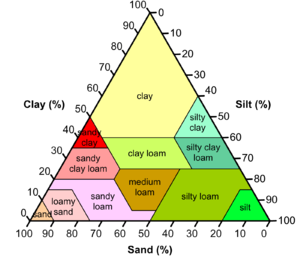Difference between revisions of "Texture"
Jenny Hill (talk | contribs) m |
Jenny Hill (talk | contribs) m |
||
| Line 1: | Line 1: | ||
__NOTOC__ | __NOTOC__ | ||
[[File:Wentworth-Grain-Size-Chart.jpg|thumb|Wentworth-Grain-Size-Chart]] | [[File:Wentworth-Grain-Size-Chart.jpg|thumb|Wentworth-Grain-Size-Chart]] | ||
| + | [[File:SoilComposition.png|thumb|SoilComposition]] | ||
Many of the physical and chemical properties of soil are affected by texture. | Many of the physical and chemical properties of soil are affected by texture. | ||
Revision as of 01:15, 8 March 2018
Many of the physical and chemical properties of soil are affected by texture.
The filter media component of bioretention, swales and green roofs must meet very specific design specifications related to texture in order for the BMP to achieve drainage and water treatment performance targets. If the media texture is too fine (i.e., contains more silt- and clay-sized particles than specified) it may have low permeability and drain too slowly or retain too much water for excessively long periods of time.
If the media texture is too coarse (i.e., contains more sand than specified) it will have higher permeability and may drain too quickly to provide adequate treatment of run-off, and may not retain enough water between storm events to sustain healthy vegetation cover.
Testing[edit]
Soil texture is most accurately characterized by submitting a representative sample to a soil laboratory for a particle-size distribution (PSD) test. Other commonly used terms for the PSD test by soil laboratories are “Particle-Size Analysis”, “Grain-Size Distribution” and “% Sand, % Silt, % Clay”. For bioretention filter media and green roof growing media, “Sand Fraction Analysis” should also be requested.
Recommended methods for determining PSD of a soil sample are provided in ASTM D6913 [1] and ASTM D7928 [2]. These methods are recommended for use in inspection and testing of LID BMPs because they include assessment of the pebble-sized particles of the soil (i.e., particles that are greater than 2 mm in diameter).
Most soil laboratories will summarize PSD test results according to the proportions of the sample made up of pebble/gravel-, sand-, silt- and clay-sized particles. When Sand Fraction Analysis is requested, a more detailed breakdown of gradations of sand-sized particles is provided, which is important for evaluating the acceptability of filter media for bioretention and dry swales. Figure 8.8 describes the Wentworth soil particle-size classification system (Wentworth, 1922) that should be used to classify pebble, sand, silt and clay fractions of a soil sample.
Evaluation[edit]
A critical part of Construction, Assumption and Verification inspections involves sampling and testing the soil component of BMPs to ensure it meets design specifications related to texture or is still within acceptable ranges for important gradations (e.g., percent silt- and clay-sized particles).
Construction inspections[edit]
If laboratory testing indicates any media texture-related parameter is not within the design or product specification ranges, notify the media or topsoil supplier, issue a “do not install” order to the construction site supervisor and contact the design professionals and property owner or project manager to determine corrective actions.
Assumption and Verification inspections[edit]
If laboratory testing indicates any media texture-related parameter is not within the design or product specification ranges, or the acceptance criteria ranges, schedule investigative work to do further sampling and testing to determine the affected area and depth and decide on corrective actions. Corrective actions for bioretention and bioswale filter media where the proportion of silt- and clay-sized particles is too high may involve removal of mulch, stone cover and plantings and tilling the top 20 - 30 cm, or removal and replacement of part or all of the filter media with material that is within acceptable tolerance ranges of design specifications.
- ↑ ASTM D6913 - 04(2009)e1 Standard Test Methods for Particle-Size Distribution (Gradation) of Soils Using Sieve Analysis https://www.astm.org/Standards/D6913.htm
- ↑ ASTM D7928-17, Standard Test Methods for Particle Size Distribution (Gradation) of Fine-Grained Soils Using the Sedimentation (Hydrometer) Analysis https://www.astm.org/Standards/D7928.htm
